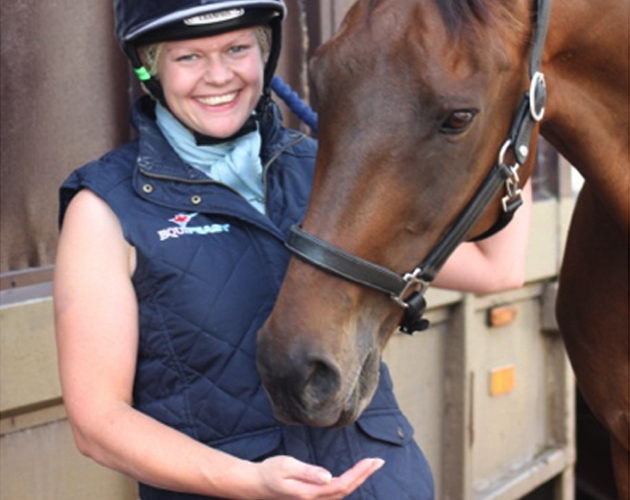Advertisement Feature
 All horses are individuals and should be treated as such, so why are people surprised that magnesium calmers do not work as often as you might expect?
All horses are individuals and should be treated as such, so why are people surprised that magnesium calmers do not work as often as you might expect?
EquiFeast have tried to delve into the links between diet (magnesium and chelated calcium in the case of calmers), horse behaviour and the science that is around in the fields of neuroscience, physiology and biochemistry.
Their contribution has been a number of field trials that they have carried out with the cooperation of customers and their vets. 
Magnesium – the good and the bad
Magnesium is a key nutrient for the horse – and many other animals for that matter – and has about 300 important roles in the body. One of the many reasons that a horse needs magnesium is to aid with energy provision at a cellular level. It makes sense that if a cell does not have enough energy, it will not function correctly and therefore the horse will not be able to assess or respond appropriately. The feedback from EquiFeast’s trials suggests that horses with blood magnesium levels towards the low end of the normal range can respond positively to magnesium supplements. This led them to believe that the “ideal range” is just a sub-set of the “normal range” that would be used to define a deficiency or an excess.
A lower than ideal blood magnesium level could probably come about with horses grazing on low magnesium pastures and being given feeds with little or no magnesium added. When in light work even small amounts of supplemented feeds may not have enough and a magnesium supplement may be beneficial.
The main revolution in EquiFeast’s thinking is that it is possible for a horse to have too much magnesium. The majority of nutritionists seem to believe that ‘any excess magnesium is just excreted’ and until they ran blood trials EquiFeast thought that too. But the biochemistry text books tell us that magnesium is difficult to control in the body. The same hormones that tightly regulate calcium in the blood also influence magnesium. They can’t readily do both. Take a look below to see how one of the horses in EquiFeast’s first blood trial responded to a high magnesium diet and what it took to get his behaviour and performance under control.
An example of how too much magnesium seems to interfere with behaviour and performance
In EquiFeast’s very first blood trial a 17-year-old three star event horse (Horse3) had a very high initial blood magnesium level. You can see from the chart it was above the normal range. They had the feed company evaluation of the diet at that time stating that it was getting 234% of the RDA for magnesium for a horse at that workload. This document also said any excess would be excreted so this was apparently fine. EquiFeast hadn’t developed the concept then but now they would calculate a Magnesium Factor for this diet as 1.6 (The target is generally 0.8).
EquiFeast gave the horse a supplement that contained both chelated calcium and magnesium as that was what they were testing at the time under the assumption that excess magnesium was excreted. Somewhat surprisingly the magnesium level at the end of loading had dropped into the normal range despite the MF of this diet now being 2.3.
Whilst there were small behavioural gains they were patchy. This horse was not the only one with a blood magnesium in the top half of normal and it was not the only up there with difficult behaviour. In fact you can see on the top chart where they now think the “ideal range” for blood magnesium lies. Another of the “top quartile” horses went onto a diet with no added magnesium and four days later was revolutionised. But they were not able to get Horse3 off its free sponsored diet for nearly another 2 years. When they did eventually get the MF down to 0.8 the rider emailed:
“Just wanted you both to know that my horse excelled at yesterday’s competition – only one down in showjumping and the only horse inside the time cross-country – he came fourth – we never get placed – as you know!
They have an even more extreme story on a video. Below is a link to a video about magnesium. Go to about two minutes 30 seconds to hear four star Australian Event Rider John Twomey describing the effects of excess magnesium on his top horse. Please bear in mind that whilst this is an extreme case, EquiFeast’s customer feedback and monitoring suggests that unnecessary supplementation of magnesium can also bring about similar issues, including a Jekyll and Hyde personality where a horse with impeccable behaviour whilst in its comfort zone will completely over react when under pressure. See the video here.
More support for the idea that the more you feed the more magnesium will be in the blood comes from a recent article in the Journal of Equine Veterinary Science.
This article was looking at skeletal issues surrounding magnesium but one of its findings was that foals supplemented with magnesium had higher blood magnesium levels than foals given a placebo. Whether foals and adults are the same is not part of this work but it is EquiFeast’s view that they do given evidence such as Horse3 and feedback from customers who take their advice and control their horse’s magnesium intake.
Types of Magnesium
One area where there is a lot of controversy is the form of magnesium used by different feed and supplements firms. The “our magnesium is better than their magnesium” syndrome. Magnesium oxide (also confusingly known as calcined magnesite) is the most commonly used in both feeds and supplements. In EquiFeast’s experience it works. They don’t actually use it in any of their products but when they look at customer’s horse’s diet they often rely on the magnesium oxide added to the formulated feeds perfectly successfully.
There are a number of different forms of chelated magnesium. These are ingredients where the magnesium is attached to an organic molecule like a sugar or an amino acid. It is a commonly held belief that organic forms of magnesium (e.g. chelates) are easier for the horse to absorb and manage and therefore are superior to inorganic forms. Based on a huge amount of customer feedback EquiFeast have concluded that any type of magnesium can bring about changes in behaviour. However it has been clear to see that significantly less organic magnesium is required to bring about the same level of change that a larger amount of magnesium oxide would achieve.
So while both forms of magnesium work EquiFeast have concluded that, when assessing a diet, they need to apply different weightings to the magnesium that occurs naturally in the basic feed (grains, fibre, starch etc), the magnesium from magnesium oxide and the magnesium from chelates. To achieve this they have developed a proprietary formula that they call our Magnesium factor (MF).
Other Nutrients to Consider
Chelated Calcium – The key thing here is the chelated part because as with magnesium it is important to differentiate between organic and inorganic sources of a nutrient. Through basic blood trials and preliminary research EquiFeast have managed to show that chelated calcium can really have outstanding results on not only behaviour but also calcium deficiency issues such as big head. Using chelated calcium as a calmer is patented to EquiFeast, meaning that it is a nutrient unique to them.
What is particularly interesting is that, in contrast to magnesium, chelated calcium has a far more dramatic effect on behaviour (and other things) than inorganic sources like limestone and calcium phosphate.
EquiFeast’s chelated calcium and magnesium research has been carried out in the same trials with the same level of rigour. But they also have one independent trial carried out by University of the West of England epidemiologist Jane Williams. Jane’s small study produced remarkably good statistical confirmation of the impact of EquiFeast’s Cool, Calm & Collected product with the magnesium level of the diet controlled. Here are the factors that showed improvements:
Skittish P<0.003
Excitable P<0.0008
Tense P<0.003
Panics easily P<0.003
Rideability P<0.0006
Competition results improved P<0.003
This study was presented as a poster to the International Society of Equitation Science conference in Denmark in August 2014 where it attracted the attention of some key scientists and, EquiFeast hope, will lead to collaborations with more researchers here in the UK.
Getting both chelated calcium and controlled magnesium right seems to produce excellent results in a large percentage of horses. Getting either wrong can lead to disappointment.
Tryptophan – This amino acid is a precursor to the neurotransmitter serotonin, sometimes called the ‘happy hormone’ – this is due to its ability to provide a sense of well-being, similar to what we feel when eating chocolate! EquiFeast have found that using tryptophan in conjunction with chelated calcium can really help improve the behaviour of horses which are suffering from pain memory and a severe lack of confidence.
Herbs – There a huge number of herbs available to aid in the calming of horses. These can help by providing some of the previously mentioned key nutrients as their active ingredients, soothing the digestive system and helping to improve other bodily functions. It is important when looking to use herbal calmers to ensure that none of the ingredients will ‘test’. For example, the popular herbal ingredient Valerian is considered to be a banned substance.
Becoming Cool, Calm and Collected
The amount of magnesium which may tip a horse over the edge can vary from horse to horse. Whilst the majority of horses on unsupplemented diets will benefit from some magnesium in their calmer, some will not – again emphasizing the point that every horse is an individual. EquiFeast have also found that there are in fact some horses which handle magnesium better than others and they can have higher levels than the majority of horses and ponies on similar diets.
It is due to this that EquiFeast not only offer their patented chelated calcium technology with varying levels of magnesium, making it the most flexible, non-bespoke calmer on the market, but also provide their customers access to a fine-tuning service to help them get the best out of their horse, regardless of how long they have been using the product.
To access their FREE advice service and identify the Magnesium factor of your horse’s current diet contact one of their experienced advice team:
Tel: 01453 836974
advice@EquiFeast.com
www.equiFeast.com





